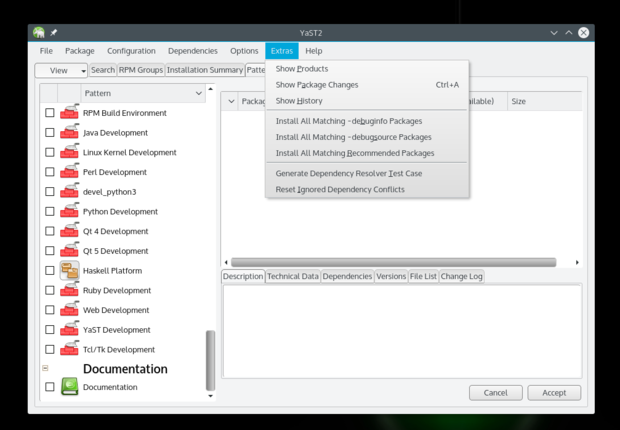Install Packages On Suse

Installing Single Software Packages under GNOME. Start YaST and click to start the package manager. From the grouping menu in the upper left corner, select. Choose from the left pane. Enter the name of the software you want to install in the search field (for example, jhead, a tool for manipulating JPEG meta data). OpenSUSE Factory is the package production system churning out high quality, up-to-date packages for openSUSE Tumbleweed and openSUSE Leap distributions. The exact same source code qualified and approved for those distributions is used for the SUSE Package Hub.
It works!Save and close the file. Then in your browser’s address bar, type the IP address of openSUSE Leap 42.2. You should see the “It works!” Web page which means Apache Web server is running correctly.If you are installing LAMP on your local openSUSE Leap 42.2 machine, just type 127.0.0.1 or localhost in the browser address bar.By default the SuSE firewall prohibit public access to port 80. To allow public access, you need to edit the firewall configurations.
Sudo nano /etc/sysconfig/SuSEfirewall2Find the following line. FWCONFIGURATIONSEXT='Change it to the following to allow public access to port 80. FWCONFIGURATIONSEXT='apache2'Save and close the file. Then restart SuSE firewall.
Yast Package Manager
Sudo systemctl restart SuSEfirewall2Finally, we need to make wwwrun (Apache user) as the owner of Document root. Sudo chown wwwrun /srv/www/htdocs/ -R Step 3: Install MariaDBInstall MariaDB server and client on openSUSE Leap using the following command. Sudo zypper install mariadb mariadb-client mariadb-toolsBy default, MariaDB won’t start automatically after installed. We can start it with: sudo systemctl start mysqlAnd enable auto start at boot time with: sudo systemctl enable mysqlCheck its status: systemctl status mysql. We can see from the screenshot that MariaDB is running and auto start enabled.Check MariaDB version: mysql -versionOutput: mysql Ver 15.1 Distrib 10.0.28-MariaDB, for Linux (x8664) using readline 5.1Now any user on the system can log into MariaDB as root with the following command: mysql -u rootTo restrict access, we need to set a password for the MariaDB root user.
Run the following command: sudo mysqlsecureinstallationWhen it asks you to enter MariaDB root password, press Enter because you have not set the root password yet. Then enter y to set the root password for MariaDB server.Next you can just press Enter to answer all the remaining questions. This will remove anonymous user, disable remote root login and remove test database. This step is a basic requirement for MariaDB database security. Now you can log into MariaDB with the following command mysql -u root -p Step 4: Install PHP7Enter the following command to install PHP7 and PHP7 extensions. Sudo zypper install php7 php7-mysql apache2-modphp7Then enable PHP module and restart Apache web server. Sudo a2enmod php7sudo systemctl restart apache2 Step 5: Test PHPCreate a test.php file in document root.

Sudo nano /srv/www/htdocs/test.phpPaste the following PHP code into the file. Save and close the file.
Now in the browser address bar, enter server-ip-address/test.php. Replace sever-ip-address with your actual IP.
If you follow this tutorial on your local computer, then type 127.0.0.1/test.php or localhost/test.php.You should see your server’s PHP information. This means PHP processing is fine. For your server’s security, you should delete test.php file now. Step 6: Install phpMyAdmin (optional)phpMyAdmin is a web-based MySQL/MariaDB administration tool. If you don’t want to administrate MariaDB from command line, then you can install phpMyAdmin with the command below. Sudo zypper install phpMyAdminZypper package manager will automatically install required PHP7 extensions for you. Once it’s installed, restart Apache to enable these PHP7 extensions.
Linux Install Packages Command Line
Sudo systemctl restart apache2Then you can visit phpMyAdmin web interface via your-server-ip/phpMyAdminor localhost/phpMyAdminAnd login with MariaDB root password.Congrats! You have successfully installed Apache, MariaDB and PHP7 on openSUSE Leap 42.2. To get latest Linux tutorials. You can also follow us on,.